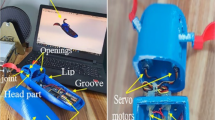Abstract
In this research, we daveloped a swimming robot with a fluttering kick of two legs which can swim freely both on the surface of the water and under the water. We have established control methods for all kinds of motion of this robot. We considered a dynamic model with undulating fins, and this has been used to construct a dynamic model of a propulsion and control system, and to analyze its motion velocity and propulsion efficiency. We proposed and designed the corresponding control algorithms to generate an appropriate thrust force and to decrease the disadvantageous influences of the interference of fluttering kicks. We can now realize free posture control and obtain various forms of motion.
Similar content being viewed by others
References
Yamamoto I, Terada Y (1995) Propulsion system with flexible/rigid oscillating fin. IEEE J Ocean Eng 20(1):23–30
Colgate JE, Lynch KM (2004) Mechanics and control of swimming. A review. IEEE J Oceanic Eng 29(3):660–673
Yu J, Wang, Tan M (2007) Geometric optimization of relative link lengths for biomimetic robotic fish. IEEE Trans Robot 23(2): 382–386
Author information
Authors and Affiliations
Corresponding author
About this article
Cite this article
Li, Y., Shimizu, E. & Ito, M. Development of under water-use humanoid robot. Artif Life Robotics 16, 469–472 (2012). https://doi.org/10.1007/s10015-011-0945-5
Received:
Accepted:
Published:
Issue Date:
DOI: https://doi.org/10.1007/s10015-011-0945-5



